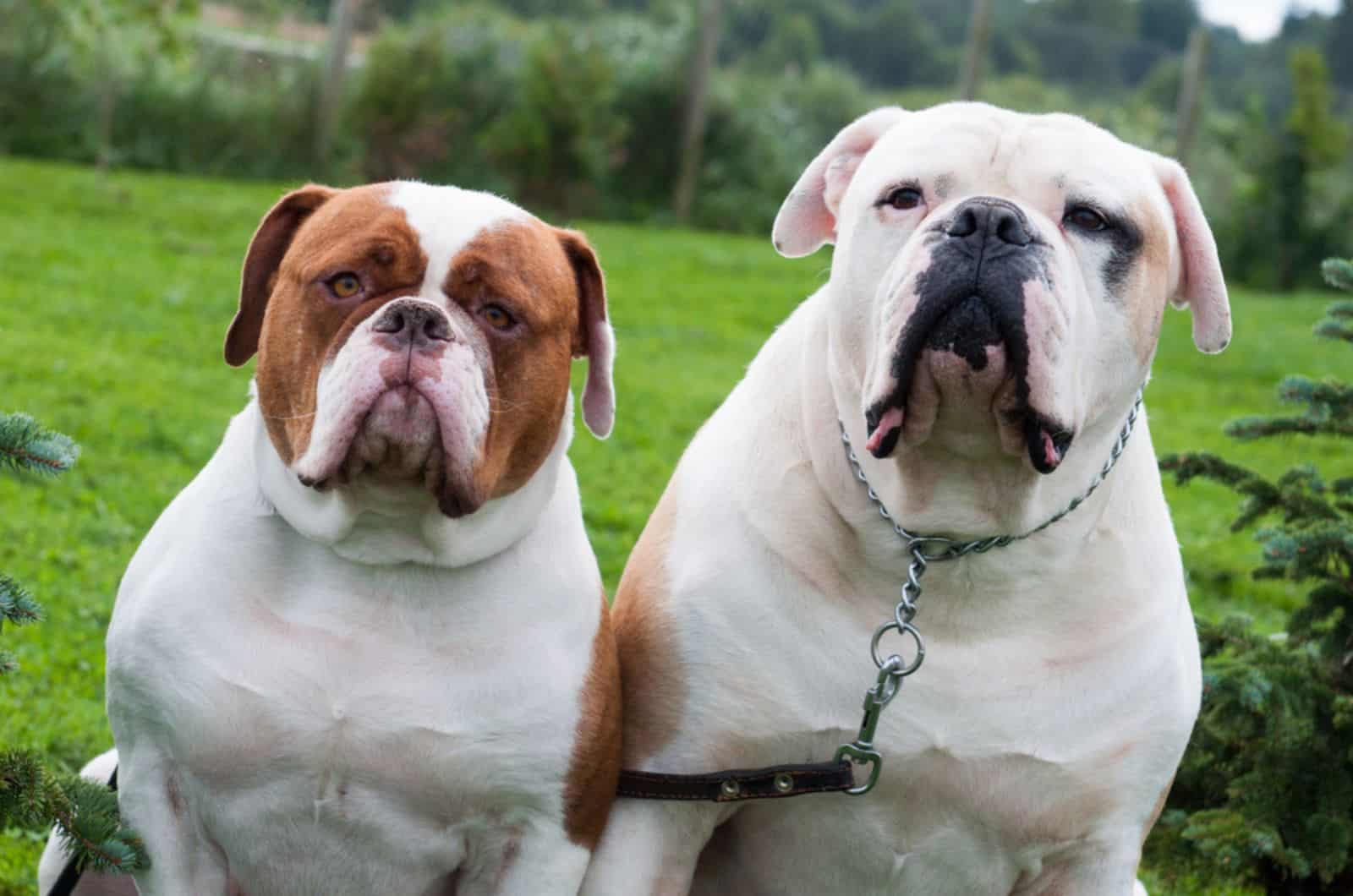Have you ever thought about how many American Bulldog colors there are? Whether your answer is yes or no, I’m sure you’ll be surprised by the number of shades of these strong doggies.
American Bulldogs are powerful canines that might look intimidating at first, but they’re actually wonderful pups that are affectionate and loyal to their family.
However, suppose you’re an owner of an American Bulldog. In that case, you should keep in mind that they require plenty of training exercises and mental stimulation in order to be good family dogs.
The shades of your pup might not be closely related to its behavior, but certain colors might make them look more intimidating.
If you’d like to know which colors American Bulldogs sport, make yourself comfortable and enter the world of these powerful beasts!
Most Common American Bulldog Colors
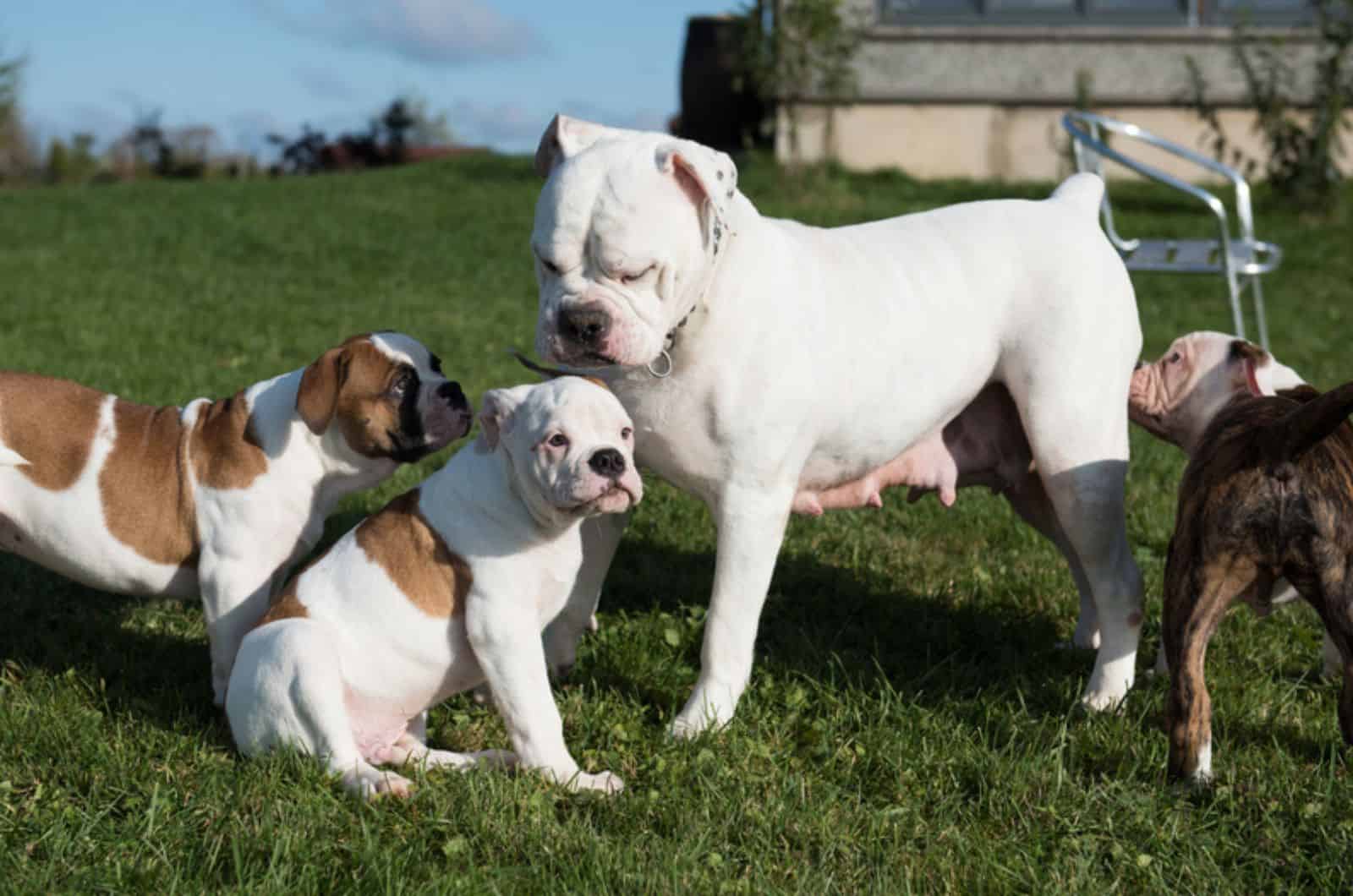
The American Bulldog can be found in beautiful shades such as brindle, blue (silver), solid white, solid black, brown, lilac, and chocolate, along with combinations of a solid background with black or tan markings.
Although these are all hues that can be found on American Bulldogs, not all of them are acknowledged by kennel institutions and organizations.
This isn’t a surprise, considering that some organizations don’t even recognize this type of Bully as a dog breed. The American Kennel Club (AKC) and the United Kennel Club (UKC) are the only two institutions that acknowledge this breed as a purebred canine.
It’s interesting to notice that even though both organizations have their own standards regarding the looks and temperament of American Bulldogs, the AKC actually doesn’t have an official breed standard for these canines.
Unfortunately, other associations, such as the Canadian Kennel Club and the Federation Cynologique Internationale (FCI) do not recognize this breed, and therefore, do not have color requirements for it either.
American Bulldog Colors Recognized By Organizations
Because of differences in canine genetics, dogs of all breeds can have distinctively colored coats. Although it’s not possible to predict the exact look of a puppy, there are ways that can help in achieving a certain shade of fur.
There are many misunderstandings and judgments that are based on the coat shades and their variations.
According to the findings of several scientific studies, there are certain medical conditions that are related to the color of the dog’s coat.
That is one of the main reasons why institutions find those colors unacceptable or “faulty”.
However, the shade of the dog’s fur is not the most important criterion because there are other considerations to take into account, such as bloodline, genetics, and the overall well-being of the pup.
American Kennel Club (AKC)
The American Kennel Club (AKC) considers white to be the standard color of American Bulldogs.
On the other hand, white and tan, white and brown, white and brindle, and white and black are examples of non-standard color combinations.
However, markings such as tan, brindle, black, red, and brown are all recognized as a standard for this type of canine.
United Kennel Club (UKC)
According to the UKC’s standard, all American Bulldog coat shades are acceptable for dog shows, except blue, black, merle, and tricolor hues and patterns, or canines with a completely black mask.
Essentially, it does not matter what shade, color pattern, or color combination you choose if it’s not one of the non-standard shades.
Solid black might not always be easily detectable as it can often be confused with other dark hues, especially under lower lighting.
Certain coat patterns, like dark brindle, can give the appearance of being solid black. Analyzing dogs in sunshine or other sources of strong light is the best way to determine whether or not their coat truly is black.
American Bulldogs By Colors
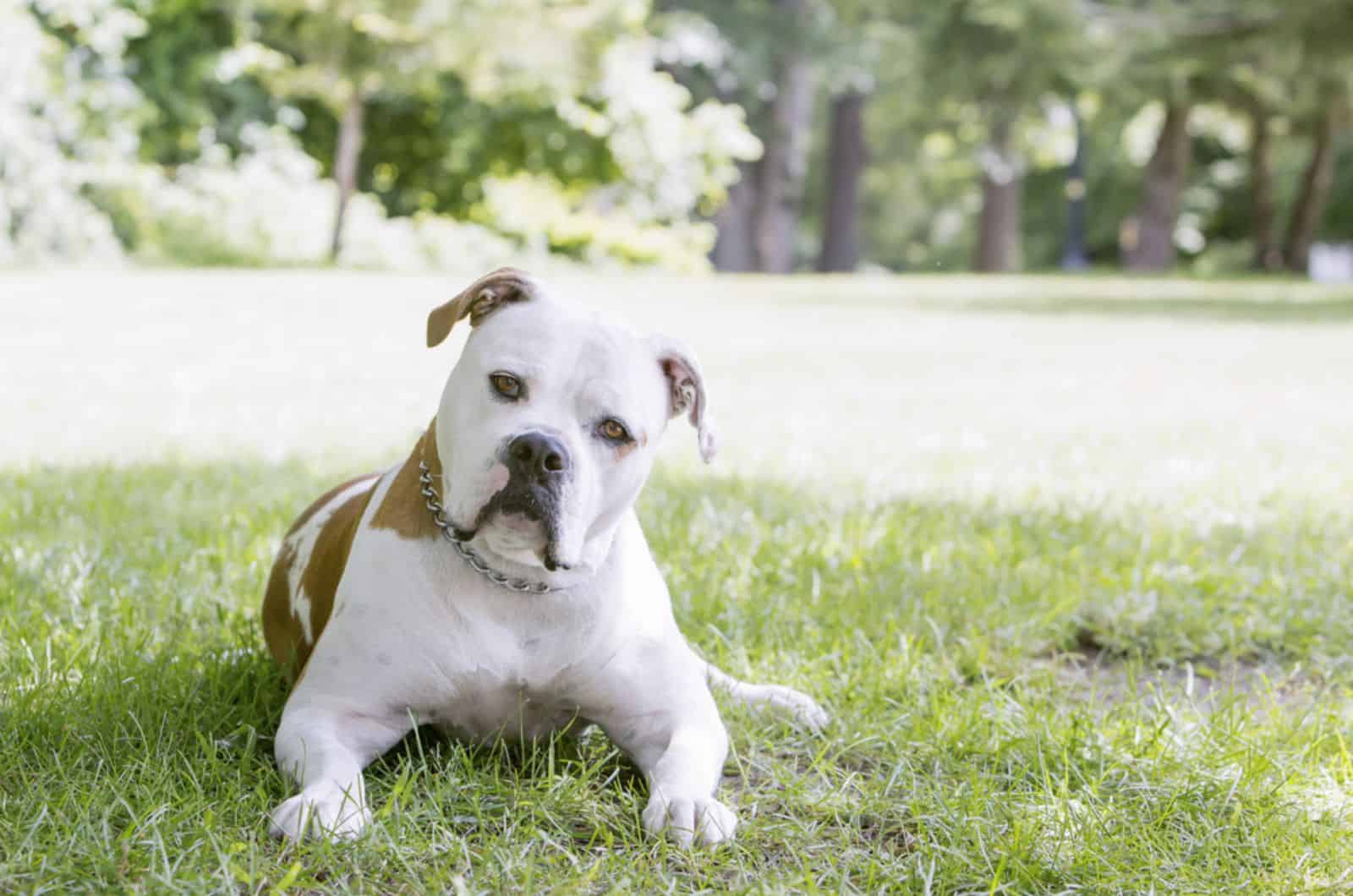
The overview of the standard and non-standard shades provided you with a general notion of how many fur hues the American Bulldog might possess.
However, now, it’s time to go into details regarding each color of this canine breed in order to explain their origin and the differences between them.
If you’re a dog enthusiast and lover of American Bulldogs, I’m sure you came across these doggies in almost every shade. However, there might be certain hues that are so rare that plenty of people haven’t had the chance to see them live.
White And Brown
This is considered one of the shades that have been recognized by the AKC, but as a part of the non-standard coat colors.
It’s one of the most common shades that appear in American Bulldogs.
The brown markings that appear in a white shade are usually located on the canine’s back and part of its head. They are placed on similar spots like other colors from white combos.
These markings are the typical shade of brown, which should not be confused with the darker shade of brown, known as chocolate, or with tan, which might be mistaken for a lighter shade of brown.
White And Brindle
The brindle shade is quite uncommon for American Bulldogs, but there are still some pups that sport this hue. Canines with the brindle pattern have a color blend that is reminiscent of tiger stripes.
You may be familiar with the brindle hue as it occurs naturally in a variety of dog breeds such as Great Danes, Dachshunds, Irish Wolfhounds, Dutch Shepherds, etc.
RELATED: 28 Brindle Dog Breeds That You Need To Check Out
The American Bulldog breed that is described as white and brindle possesses a white coat with brindle spots all over its body.
This doggie is considered interesting and unique because of the brindle shade that can include a variety of different combinations such as black, brown, red, or fawn that appear as stripes.
The brindle and white American Bulldog is truly beautiful in every way, but it’s those stripes that really make them stand out from other pups.
White And Tan
As I mentioned above, this type of doggo is often confused with the white and brown Bulldog mostly because tan is often considered a lighter shade of brown. However, nowadays, it’s recognized as a separate shade.
The white and tan American Bulldog, just like other breeds with dominant white fur, has a coat that is mostly white with tan markings.
When contrasted with darker-colored markings, such as black and brown, the tan spots on this dog breed do not stand out that much.
Despite this, Bulldogs with this type of fur are no less adorable than pooches in other shades.
Solid White
This is the only color that is recognized as a standard by the AKC, and the white American Bulldog has a coat that is entirely white in hue.
They are considered “Snow Whites” among American Bulldogs, although they still look like one of the scariest dog breeds with their strong jaws and muscled body.
A solid white American Bulldog is a canine that has no other markings or spots on its body, including its face, ears, back, and tail.
Some people might even call them “platinum”, but that is rather a misconception as platinum American Bulldogs refer to canines that lack pigment in their fur.
There are people who find platinum to be a white shade with blue DNA, but that could also be described as a blue shade that is diluted into white-like fur.
Solid Black
As you can imagine, a solid black American Bulldog is one that has completely black fur, although it often possesses a few white spots on its chest and head.
These pups are usually regarded as one of the most elegant bully types as they seem like they’re wearing a tuxedo. Black is usually considered a sophisticated shade that makes both people and dogs look more powerful and self-confident.
However, although they’re not very rare, these doggies do not comply with the breed standards of either the AKC or the UKC, even though solid white is acceptable.
In spite of their lack of popularity, black American Bulldogs make excellent family pets and protectors of their property. As a matter of fact, black American Bulldogs look even more massive than other Bullies, so it might be a good idea to get one if you’re looking for a big guard dog.
White And Black
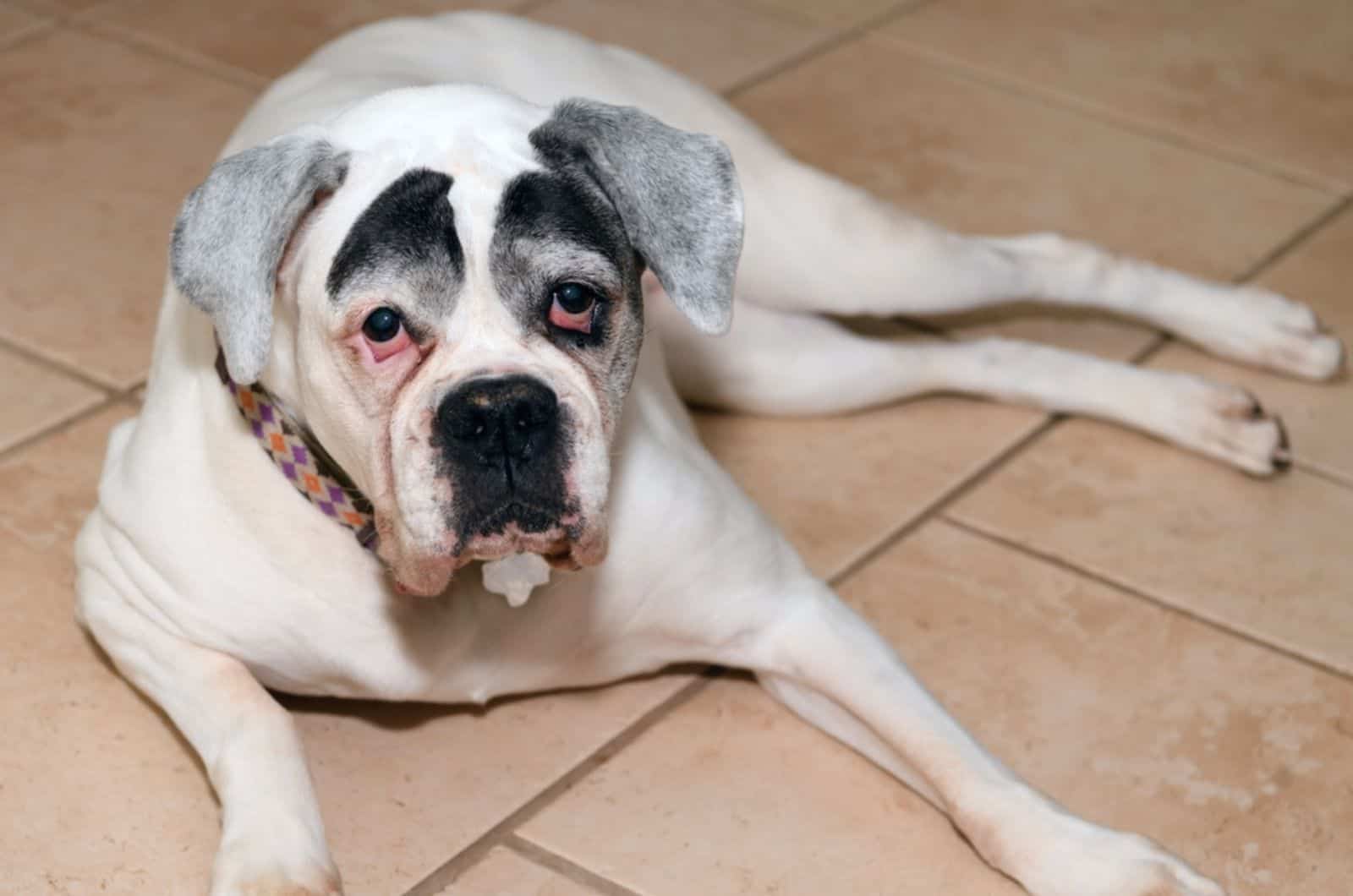
Although both solid black and white and black canines have white shade as a part of their fur, they cannot be mistaken by any means.
The white and black American Bulldog has white as the main shade of the coat, with black spots that appear in certain places.
The spots on each canine are unique to that particular pooch, so there’s no exact way to predict how many black patches will appear, or where.
That is one of the main reasons why each of these black and white athletic dogs looks unique, although they’re generally categorized under the same shade.
Due to the fact that black and white are complementary colors, an American Bulldog with this color combination is quite a handsome large dog.
Chocolate (Brown)
The chocolate hue in canines can be defined as a deeper shade of brown that looks similar to chocolate (which is probably why these pooches are so sweet).
This shade is often confused with brown, although they’re not exactly the same.
The chocolate shade can appear either as a dominant hue on the dog’s fur or in combination with a white shade.
Bulldogs with chocolate hair often have paw patches and eyeliners that are the same color as their coat.
If you go through your dog’s coat in the opposite direction from hair growth, you might notice a fawn undercoat hiding under the chocolate hair.
Lilac
This is one of the rare shades that American Bulldogs can appear in. The coat of these pups often looks like they’re washed out, which is why some people discuss it not being a true shade at all, although it’s recognized as a non-standard hue.
This is due to the fact that the lilac fur shade is actually a diluted form of the color, black.
However, you might be surprised to discover that the lilac hue isn’t diluted only once, but twice.
This helps to explain why lilac American Bulldogs have a coat that is more grayish in appearance, and are close in color to lilac or a purple tint.
Their paw pads and lines around the eyes and nose are usually the same shade as the rest of the coat.
Blue (Silver)
Even though this color often appears not only in blue American Bulldogs, but other canine breeds, this doesn’t mean that those doggies are exactly blue (at least not like the pup from Blue’s Clues).
This type of blue appears more like a variation of a gray shade, which originates from the solid black shade that was diluted to a grayish-blue kind of color.
American Bulldogs are not the only pooches that sport this shade. There are also blue American Bullies, Great Danes, Boston Terriers, German Shepherds, English Bulldogs, and plenty of other breeds.
Merle
This is one of the most common shades among dog breeds. I know it might sound confusing at first, but there’s almost no type of dog that doesn’t have a merle gene in its bloodline.
Still, pups with a merle coat are quite rare within their breed, and they’re usually considered “faulty” or not up to the breed standards.
The Veterinary Genetics Laboratory at the University of California, Davis, defines merle as a pattern that appears unevenly on a dog’s coat, in patches that are a combination of diluted and solid pigments.
The merle pattern is not exclusive to American Bulldogs; it also appears in a great number of other dog breeds, such as Chihuahuas, Catahoulas, Doxies, Aussies, Pitbulls, Corgis, and others.
READ NEXT: All About The Merle Chihuahua: Is This Coat Color Rare?
Merle markings can appear in a variety of shade combinations, including white, blue, black, and brown.
Merle American Bulldogs are indeed unique pups. They might look different from other Bulldogs, but their distinctive shade doesn’t make them any less valuable as family members and excellent watchdogs.
What Is The Most Common Shade Of American Bulldogs?
Every reputable breeder of American Bulldogs is focused on the production and raising of canines that comply with the breed guidelines set by reputable kennel clubs.
RELATED: Johnson American Bulldog Breeders In The United States
Before we continue discussing the most common shade of American Bulldogs, it’s important to mention that there are two types of these canines: the Johnson type, which is considered a common Bully type, and the Scott type, which many people consider as the standard American Bulldog.
White is the hue that the AKC considers to be the standard for this breed. Because of this, the white variety of the American Bulldog is the one that is regarded to be the most frequent among its color types.
Why is this important to mention? Because these two bloodlines show differences in colors as well.
The most common shade of an American Bulldog is white, which is usually found in the Scott type of Bulldogs. Johnson American Bulldogs may have a white shade on their coat, but it’s usually combined with patches of different hues.
Even though white appears most commonly in this breed group, other frequent shades are white and black, white and tan, and white and brown.
What Is The Least Common Shade Of American Bulldogs?
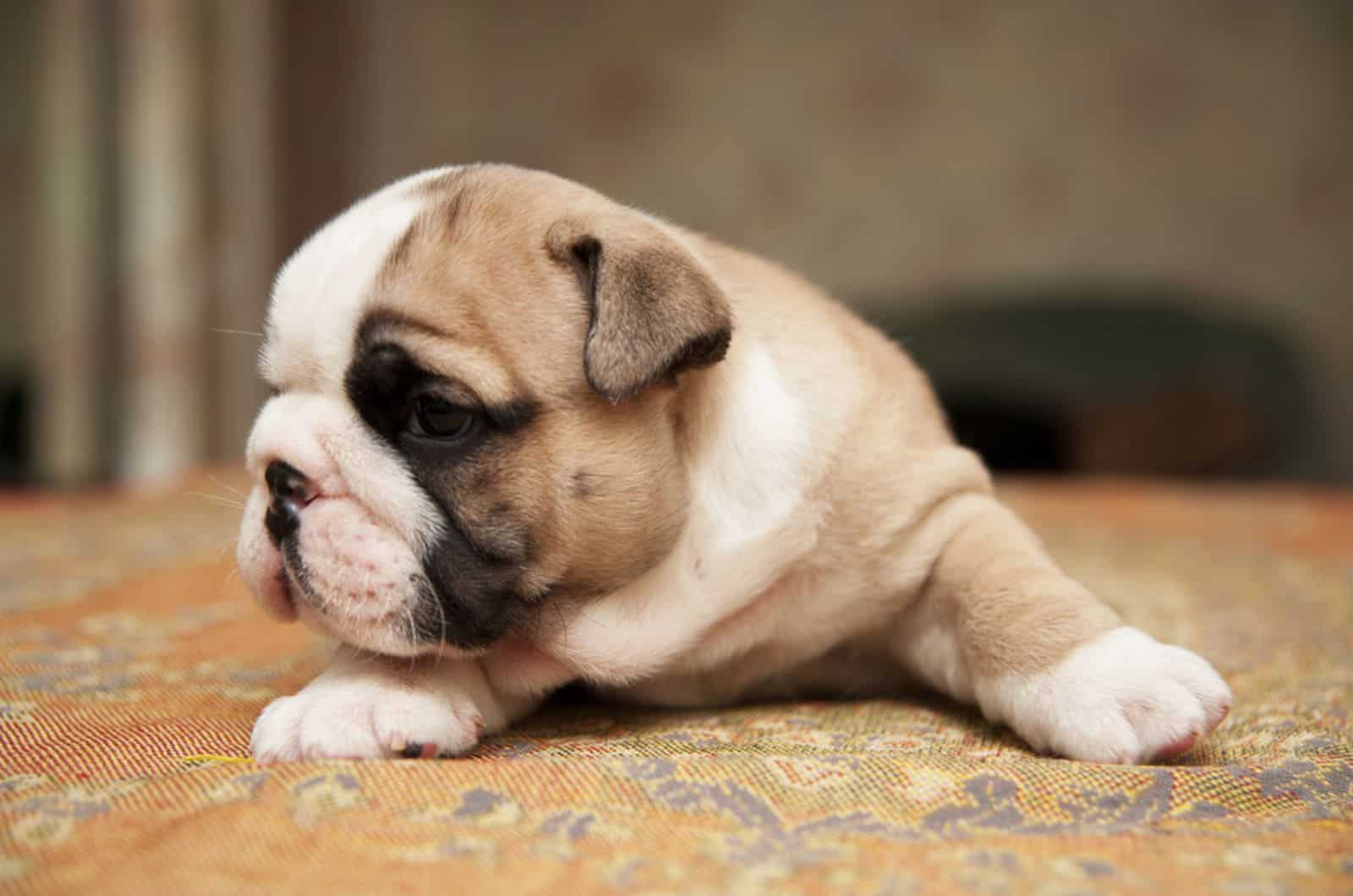
After discussing the most common color of these powerful doggies, it’s time to talk about the rarest hue of their coat that not many people have seen (at least not live).
In most cases, breeders adhere to the requirements set out by kennel clubs, which, in the case of the American Bulldog, specify that the dog should be white.
Therefore, the uncommon shades of these pups are those that aren’t recognized as standard shades (black, lilac, merle, blue, and chocolate).
The main reason why these shades are rare is that a great number of reputable breeders focus on breeding standard-colored American Bulldogs that can be a part of conformation events and dog competitions.
Due to the fact that certain fur shades are not regarded as standard, the owners of such American Bulldogs affectionately refer to their pups as “American Bulldogs of color.”
How Come American Bulldogs Have So Many Coat Colors?
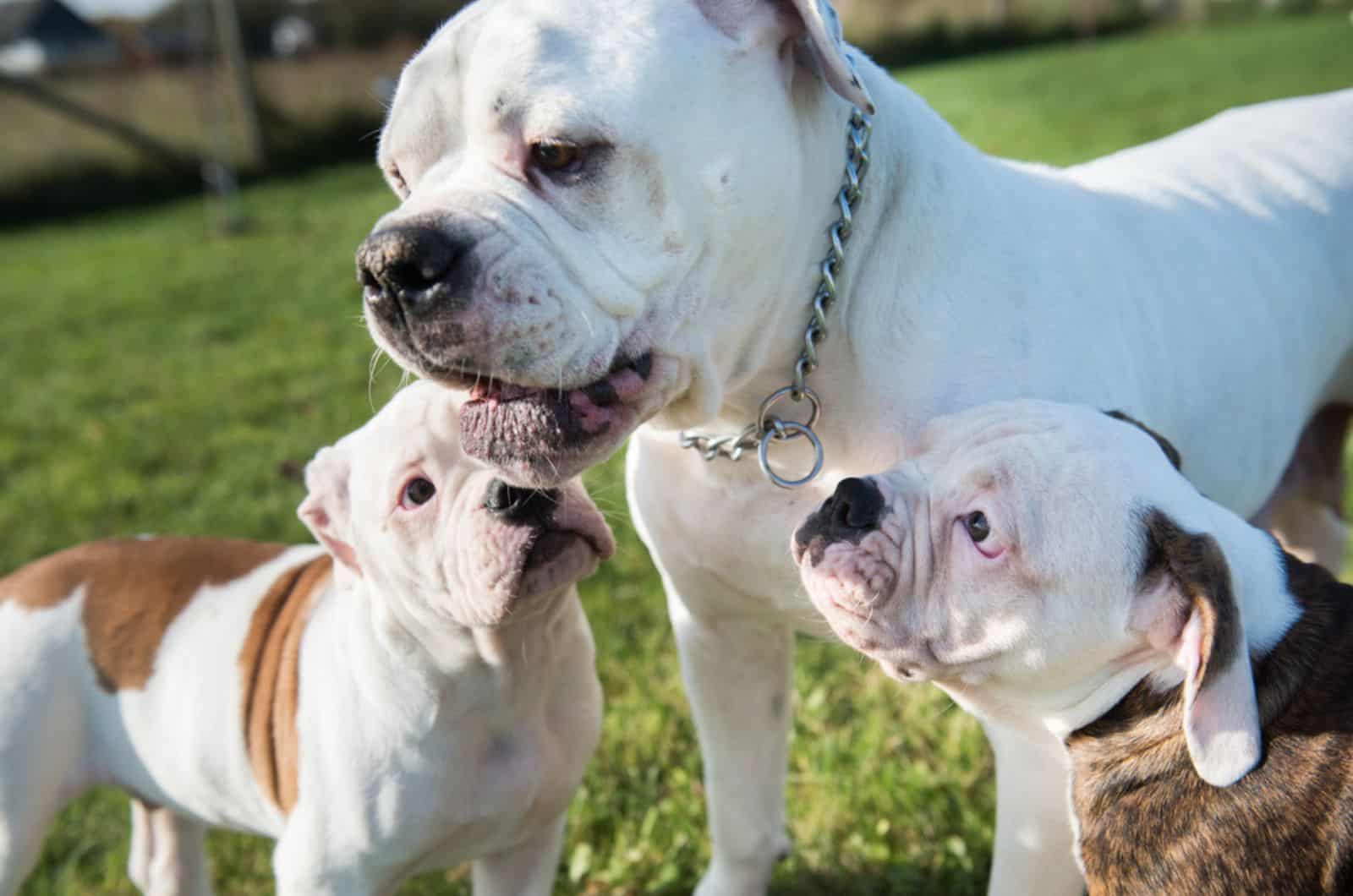
Your dog’s genetic pool is the only factor that can determine the color of its fur and the pattern it will have. There is no way to predict with absolute certainty the coat color of a litter of puppies before they are born.
Even though they originate from the same litter, the American Bulldog puppies that you buy could have various-colored coats.
The study of canine genetics is quite fascinating, but it’s also very complex and requires plenty of research.
We will do our best to explain their view on American Bulldog shades as simply as possible.
There are two aspects of a canine’s coat that are controlled by its genes: the color, and the texture.
First, genes have the ability to control the production of pigments, which determines the shades of your pet.
Secondly, genes have an influence over the locations where these pigments are manufactured, which is the reason why there are solid colors, bi-colors, brindled shades, and merle hues in coats.
There is also the possibility that color genes might dilute each other, resulting in distinct colors. One of the best examples of this process is the lilac American Bulldog.
Lilac canines are essentially dogs colored in the black shade, which has been diluted two times into a grayish type of hue that is reminiscent of the lilac shade.
Can Coat Shade Affect A Dog’s Behavior And Health?
Fur colors are often related to certain diseases or medical conditions in canines, although there’s still not enough evidence that the color gene can have an influence on a dog’s health.
However, this doesn’t refer to the white shade, but only the type that is a result of a lack of pigmentation. Pups with this type of hue are prone to hearing impairment, allergies, and other conditions, which has been proven multiple times.
When it comes to the general health of American Bulldogs, considering that their lifespan is usually between ten and sixteen years, it can be said that they’re in quite good health.
When kept in good condition, and with proper attention, these dogs have the potential to live for a long time, so it all depends on their genetic background and living environment.
The health of your canine might not be affected by colors, but by a variety of other things, including its ancestry, lifestyle, diet, and level of physical activity.
Keep in mind that American Bulldogs can be prone to certain conditions
You should always be on the lookout for these frequent health hazards with your American Bulldog regardless of what color he or she is.
Common Health Issues Of American Bulldogs
• Hypothyroidism is a condition that frequently affects Bulldogs because of their proneness to thyroid issues. The body of your pet is unable to create enough thyroid hormone, which results in symptoms such as anxiety, excess weight, and loss of hair, along with modifications in behavior, such as aggressiveness.
• Hip Dysplasia is an anatomical condition that causes discomfort and a limp in Bulldogs. The condition occurs when the thigh bone does not properly fit into the hip joint.
• Cherry eye is a common name for the discomfort and redness that occur when the third eyelid of your pooch becomes inflamed or “pops out.”
Temperament
There have been certain concerns regarding the impact of coat shades… better to say color genes, on the personality and behavior of American Bulldogs.
Certain dog experts and enthusiasts have begun this discussion, although there are no studies yet that definitely prove or deny the influence of color on dog behavior.
It is true that certain fur shades can make some American Bulldogs look more powerful and intimidating, but that is related purely to their physical appearance as there’s no guarantee that this canine will show more aggressive behavior than a dog in another shade.
In general, American Bulldogs are known for their sociability, intelligence, and playful nature.
It is a common misunderstanding that they are hostile to humans due to their history of participating in bull-baiting events; in reality, they are wonderful family companions, great working dogs, and amazing watchdogs.
Early socialization and obedience training are key to having a well-behaved and obedient furry companion at home, be it an American Bulldog or any other type of canine.
Do American Bulldog Puppies Change Coat Shades As They Grow?
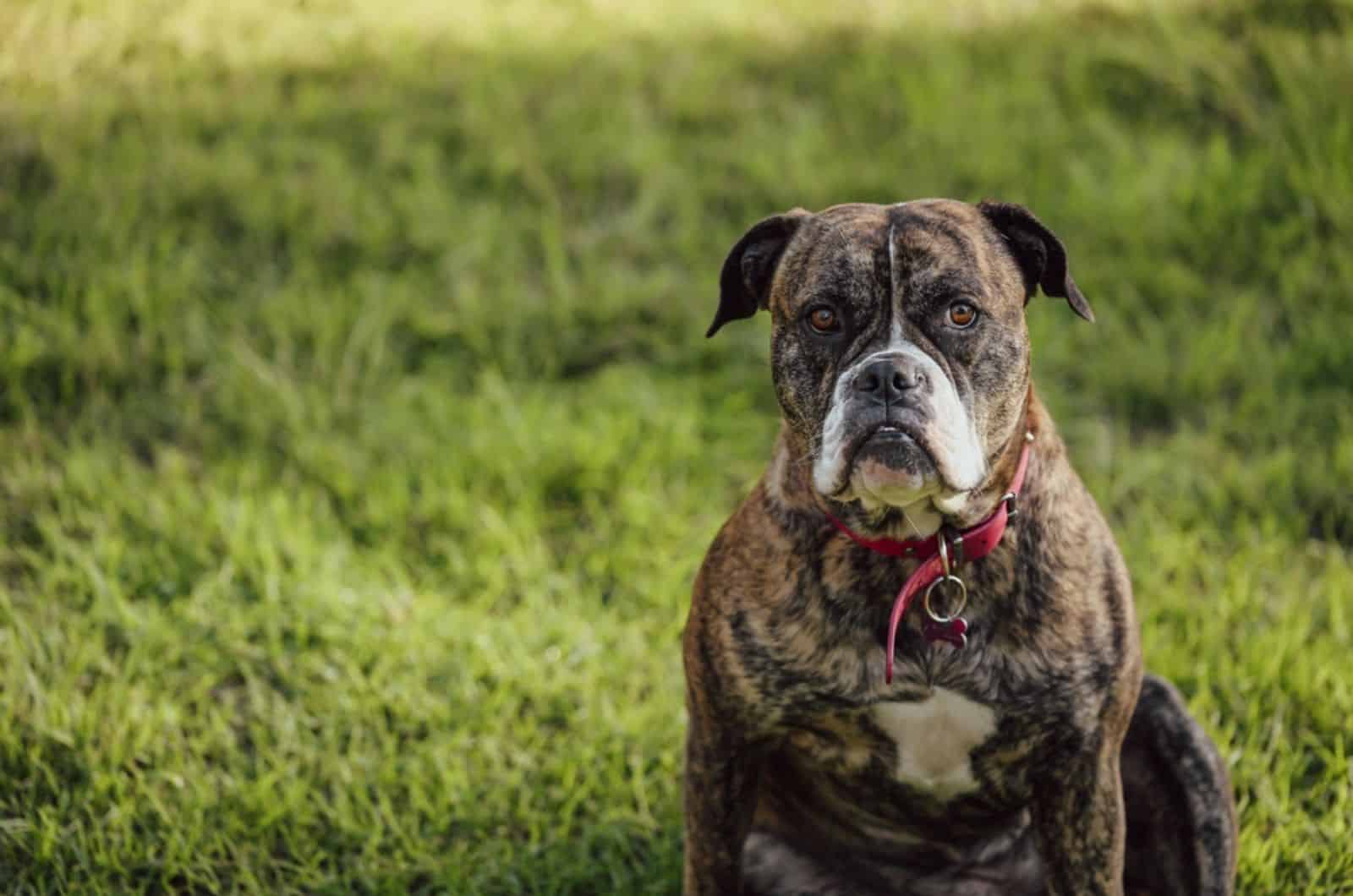
The colors of American Bulldog puppies are defined by their DNA even before they are born.
The pattern and color of their fur, regardless of what it looked like when they were born, will remain the same until they are completely grown.
On the other hand, when they mature into adults, it is not unusual for their fur to lighten or darken in color.
Read More: American Bulldog Growth Chart: Everything You Should Know
On a case-by-case basis, it is possible that it will take on a different tone, but it will rarely completely change color.
This essentially explains why you’ll rarely see two American Bulldogs of the same exact shade and pattern.
Those who can’t wait to find out what color their pups will have can perform DNA tests on the parent breeds.
FAQs
Due to the fact that both the American Bulldog and the English Bulldog belong to the Bulldog breed, they are frequently confused with one another.
Still, the majority of Bully lovers will be able to tell them apart with just a quick glance because of the differences in physical appearance.
In contrast to their American counterparts, English Bulldogs are stocky in build, and they have relatively short legs. American Bulldogs, on the other hand, have a slimmer, more athletic body, and longer legs.
When it comes to the shape of their head and face, both male and female English Bulldogs are characterized by having a large head and wrinkled features. On the contrary, American Bulldogs tend to have fewer wrinkles on their face, and they have a stronger jaw.
Because of their small stature, English Bulldogs are suitable for ownership as lap dogs. In comparison, American Bulldogs are considerably bigger, which isn’t a surprise considering that they were initially bred as working canines, stock dogs,and catch dogs.
READ NEXT: 10+ English Bulldog Colors: All About Standard & Rare Colors
This type of canine is best known as a relative of the Old English Bulldog. The story of their origin says that they appeared with working-class immigrants in the United States in the 17th century.
American Bulldogs were used as catch and working canines, but they were also good at securing properties. However, although they possessed great skills, they were nearly extinct during the World War period.
Fortunately, two men who were named John D. Johnson, and Allen Scott, took matters into their own hands and saved this precious breed.
This is the story of how the two separated types of American Bulldogs got their name.
Considering that they share more physical traits with Pit Bull Terriers than with English Bulldogs, it’s no surprise that many people mix them up.
Final Thoughts
The number of American Bulldog colors might be surprising to some, especially people who don’t see any specific difference between shades that appear on patches of bicolor American Bulldog pups.
It’s difficult to predict which type of color your future pup will possess, but as a dedicated pet parent, I’m sure the health of your pooch will be your number one priority, so it won’t really matter which shade your pet’s fur is.
If you’re looking for a specific color, the best way to achieve it is by contacting American Bulldog breeders until you find the puppy of your choice.
READ NEXT:
Is American Bulldog Ear Cropping Necessary And Ethical?
An American Bulldog Feeding Chart For Your Eyes Only
American Bulldog Vs Pitbull Terrier: Which One Is The Better Dog Breed For You
